Home / Bulky Bases in Elimination Reactions
Elimination Reactions
Bulky Bases in Elimination Reactions
Last updated: June 23rd, 2025 |
Elimination Reactions Using “Bulky Bases” – When The Zaitsev Product Is Minor
We’ve recently talked about Zaitsev’s rule in elimination reactions, and how the transition state leading to the more substituted alkene is lower in energy. This post covers reactions involving “bulky bases” where less of the Zaitsev product is obtained.

Table of Contents
- “Normal” E2 Reactions Follow Zaitsev’s Rule, Giving The “More Substituted” Alkene
- “Bulky Bases” Tend To Give A Higher Proportion Of “Non-Zaitsev” Products
- Bulky Bases Give More “Non-Zaitsev” Products Due To Steric Interactions With The Alkyl Halide
- Two Common Bulky Bases Are The t-Butoxide Ion And Lithium Di-Isopropyl Amide (LDA)
- Notes
- Quiz Yourself!
- (Advanced) References and Further Reading
1. “Normal” E2 Reactions Follow Zaitsev’s Rule, Giving The “More Substituted” Alkene
Most elimination reactions follow Zaitsev’s rule : you should expect that the “more substituted” alkene will be formed if at all possible. Like in the elimination reaction below, for instance, we get 80% of the tetrasubstituted alkene [“Zaitsev” – more substituted because there are 4 carbons attached to the alkene] and 20% of the disubstituted “non-Zaitsev” product.

The Zaitsev product generally forms because the more substituted alkene is generally more stable. (See article: Alkene Stability)
However, today we’ll talk about one interesting exception to this “rule” and how under certain conditions we actually end up with the “non-Zaitsev” alkene product instead.
2. “Bulky Bases” Tend To Give A Higher Proportion Of “Non-Zaitsev” Products
For instance, instead of using sodium methoxide, (NaOCH3) if you use the base NaOC(CH3)3 [or KOC(CH3)3, changing sodium for potassium doesn’t really matter here] you end up with an interesting reversal of products!

So what’s going on here? Why might we get less of the Zaitsev product here and more of the “non-Zaitsev” product?
3. Bulky Bases Give More “Non-Zaitsev” Products Due To Steric Interactions With The Alkyl Halide
Well, if we draw out what the structure of the reactants might look like in their transition state, we can start to see why. [Note: this is not technically a transition state since we’re not drawing partial bonds, but you can at least see how the reactants are assembled].
The base in this instance – potassium t-butoxide – is an extremely bulky base, and the proton we remove to form the Zaitsev product is on a tertiary carbon. As the oxygen from the base draws nearer to this proton, a steric clash occurs.
In essence the electron clouds around the methyl groups are interacting with each other, and the repulsion between these clouds will raise the energy of the transition state [remember – opposite charges attract, like charges repel]. This will slow down the reaction.

Looking at the reactant assembly that produces the non-Zaitsev product, the bulky base is removing a proton from a primary carbon. Steric clash is considerably reduced in comparison to that for the Zaitsev product. Elimination is faster, and we therefore end up with the less substituted alkene as our major product.
This is one example of a reaction where the more thermodynamically stable product is not formed. [recall that alkene stability increases with the number of carbons directly attached to the alkene].
4. Two Common Bulky Bases Are The t-Butoxide Ion And Lithium Di-Isopropyl Amide (LDA)
So the bottom line for this post is that when performing an E2 reaction, using a bulky base will produce a greater proportion of non-Zaitsev alkene products relative to a less bulky base.
As far as we’ll see, the most common “bulky base” we need to consider is the t-butoxide ion, which can be drawn in many forms [see diagram]; occasionally you might see lithium di-isopropyl amide (LDA) used as well. For our purposes this completes the roster of bulky bases.
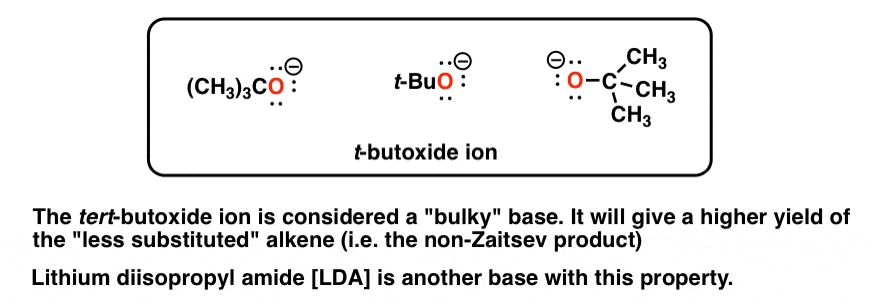
In the next post we’ll talk about an interesting observation we can make during certain E1 reactions.
Next Post: Comparing the E1 and SN1 Reactions
Notes
Related Articles
- Elimination Reactions (2): The Zaitsev Rule
- Antiperiplanar Relationships: The E2 Reaction and Cyclohexane Rings
- Reagent Friday: Potassium tert-butoxide [KOC(CH3)3]
- Reagent Friday: Lithium Di-isopropyl Amide (LDA)
- Alkene Stability
- The Hofmann Elimination
- Elimination (E2) Practice Problems and Solutions (MOC Membership)
Quizzes

Become a MOC member to see the clickable quiz with answers on the back.
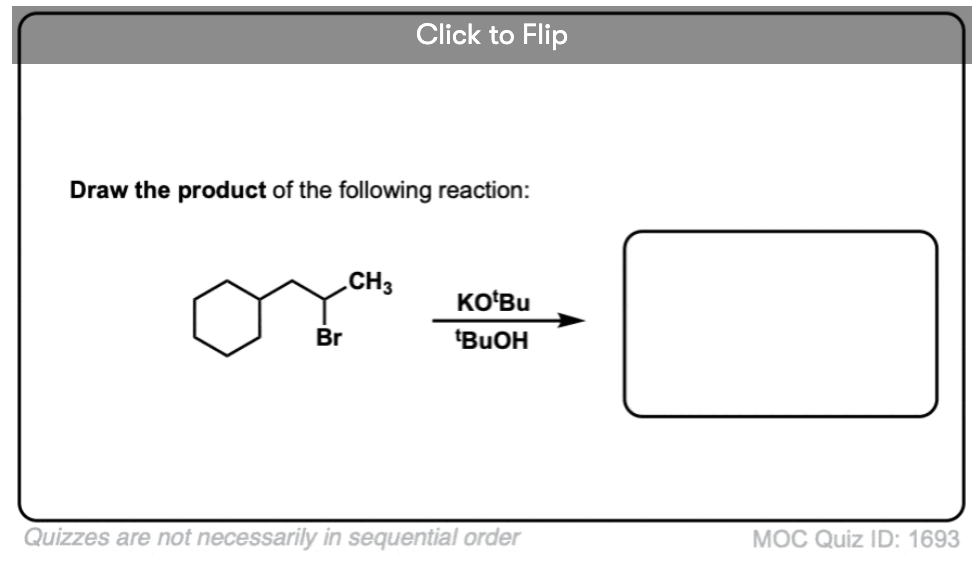
Become a MOC member to see the clickable quiz with answers on the back.
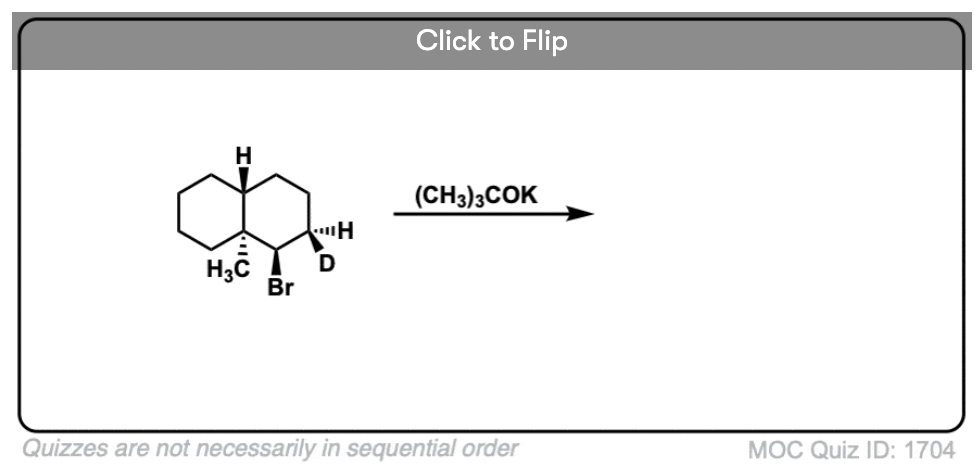
Become a MOC member to see the clickable quiz with answers on the back.
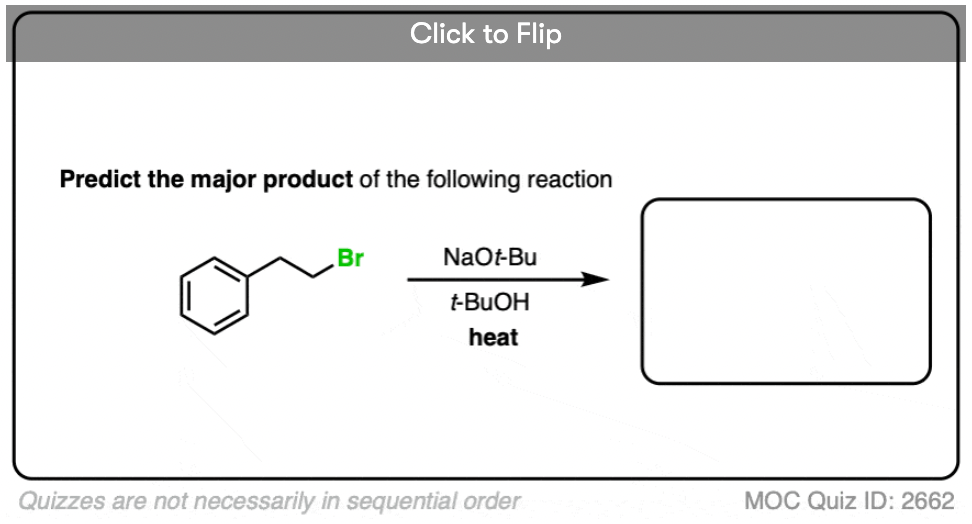
Become a MOC member to see the clickable quiz with answers on the back.

Become a MOC member to see the clickable quiz with answers on the back.
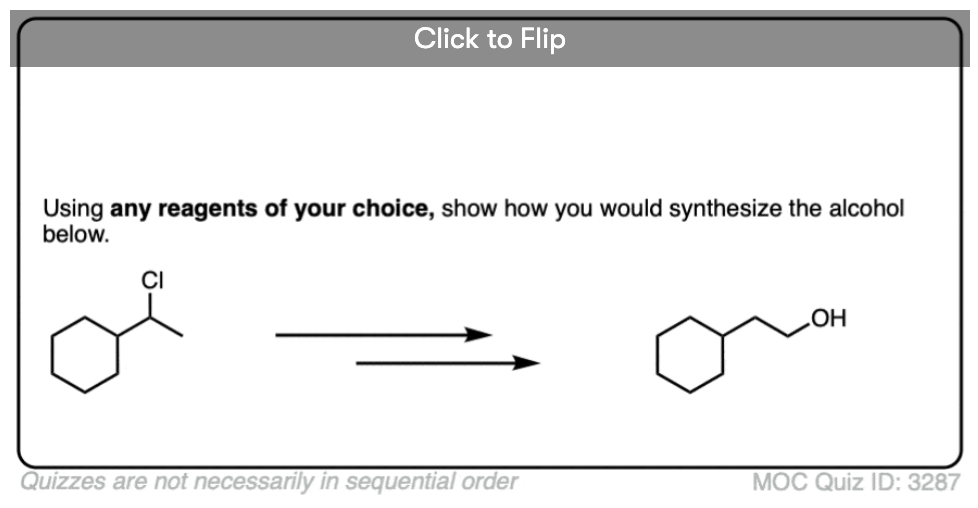
Become a MOC member to see the clickable quiz with answers on the back.
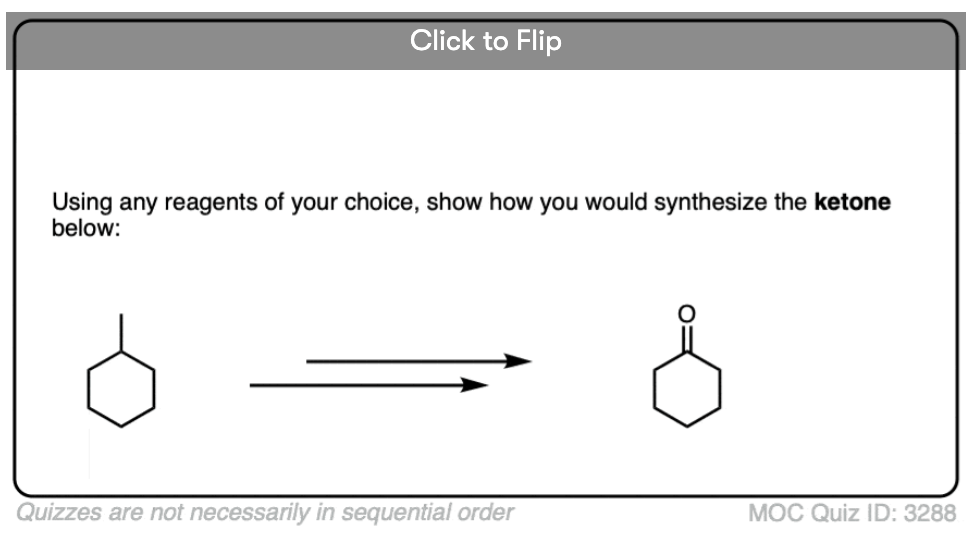
Become a MOC member to see the clickable quiz with answers on the back.
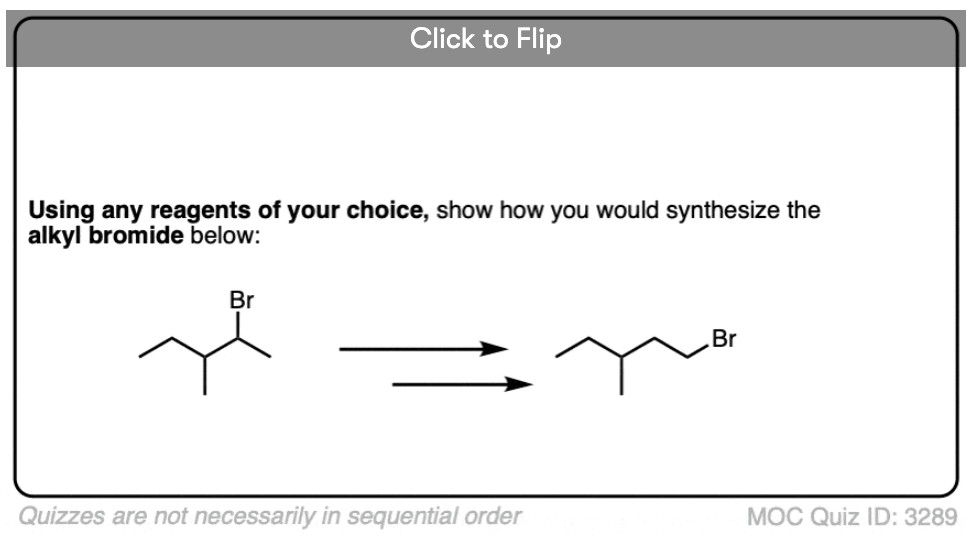
Become a MOC member to see the clickable quiz with answers on the back.
(Advanced) References and Further Reading
- For an example where a bulky leaving group can lead to “non-Zaitsev” (aka “Hofmann”) products, see this post on the Hofmann Elimination.
- Stereochemical and base species dichotomies in olefin-forming E2 eliminations
Richard A. Bartsch and Jiri Zavada
Chemical Reviews 1980 80 (6), 453-494
DOI: 10.1021/cr60328a001
A pretty comprehensive review containing many examples of Zaitsev and Hofmann-selective elimination reactions. - Mechanism of elimination reactions. Part X. Kinetics of olefin elimination from isopropyl, sec.-butyl, 2-n-amyl, and 3-n-amyl bromides in acidic and alkaline alcoholic media
M. L. Dhar, E. D. Hughes, and C. K. Ingold
J. Chem. Soc. 1948, 2058-2065
DOI: 10.1039/JR9480002058
Table I in this paper shows that solvolysis of 2-bromobutane with 1 M NaOEt in ethanol gives 82% yield of alkene at 25 °C, but similar solvolysis at 80 °C gives 91.4% yield of alkene. - Beiträge zur Kenntniss der flüchtigen organischen Basen
Aug. Wilk. von Hofmann
Just. Lieb. Ann. Chem. 1851, 78 (3), 253-286
DOI: 10.1002/jlac.18510780302
Early paper on Hofmann eliminations by its discoverer. Eliminations of quaternary ammonium salts favor loss of ethylene over larger groups. - —The nature of the alternating effect in carbon chains. Part XVIII. Mechanism of exhaustive methylation and its relation to anomalous hydrolysis
Walther Hanhart and Christopher Kelk Ingold
J. Chem. Soc. 1927, 997-1020
DOI: 10.1039/JR9270000997
Prof. Ingold mentions in this paper, “It follows from the basic hypothesis that the ease of removal of the b-proton (reaction A) depends (a) on its vulnerability, (b) on the proton-avidity of the attacking anion” - Steric Effects in Elimination Reactions. VII. The Effect of the Steric Requirements of Alkoxide Bases on the Direction of Bimolecular Elimination
Herbert C. Brown, Ichiro Moritani, and Y. Okamoto
Journal of the American Chemical Society 1956, 78 (10), 2193-2197
DOI: 1021/ja01591a047
As Nobel Laureate Prof. H. C. Brown (Purdue) states in this paper, “[…] with increasing basic strength of the alkoxide bases (C2H5O– < (CH3)3– < CO–) there is observed not a decrease, but rather an increase in the selectivity of the reagent. It may be concluded therefore that the increase in base strength does not play any major role in altering the isomer distribution in the present reaction.”
Check out Table IV. For 2-bromobutane, 1.0 M KOtBu gives a 53:47 ratio of 1-butene to 2-butene. For 2-bromopentene, it’s 66:34 for 1-pentene vs 2-pentene. The ratio of “anti-Zaitsev” alkenes gets higher when the bromide is tertiary; for 2-bromo-2-methylbutane and 1.0 M KOtBu the ratio is 72:28 for the “anti-Zaitsev”. [30:70 when the base is KOEt].
If you’re really interested see this chart (thanks, Ben!) Olefin Product Distribution - Steric Effects in Elimination Reactions. IX. The Effect of the Steric Requirements of the Leaving Group on the Direction of Bimolecular Elimination in 2-Pentyl Derivatives
Herbert C. Brown and Owen H. Wheeler
Journal of the American Chemical Society 1956, 78 (10), 2199-2202
DOI: 1021/ja01591a049
In this paper, Prof. Brown shows that, all things being equal, bulkier leaving groups also lead to formation of less substituted olefins. 2-bromopentane gives 31% yield of 1-pentene upon solvolysis with KOEt, but 2-(trimethylammonium)-pentane gives 98% of yield of 1-pentene. - Steric Effects in Elimination Reactions. X. Steric Strains as a Factor in Controlling the Direction of Bimolecular Eliminations. The Hofmann Rule as a Manifestation of Steric Strain
Herbert C. Brown and I. Moritani
Journal of the American Chemical Society 1956, 78 (10), 2203-2210
DOI: 1021/ja01591a050
This is Prof. Brown’s paper wrapping up the topic of steric effects in E2 eliminations. Prof. Brown used various pyridine bases varying in steric hindrance around the nitrogen (pyridine, 2-methylpyridine (2-picoline), and 2,6-dimethylpyridine (2,6-lutidine). Increasing the steric bulk of the base does increase the yield of the less substituted olefin. - Mechanism of elimination reactions. Part XIX. Kinetics and steric course of elimination from isomeric menthyl chlorides
E. D. Hughes, C. K. Ingold, and J. B. Rose
J. Chem. Soc. 1953, 3839-3845
DOI: 10.1039/JR9530003839
This is an example of the Zaitsev rule in a cyclohexane system. Neomenthyl chloride gives 78% 3-menthene and 22% 2-menthene with EtO– in ethanol. - Eliminations in Cyclic cis‐trans‐Isomers
Dr. W. Hückel and Priv.‐Doz. Dr. M. Hanack
Angew. Chem. Int. Ed. 1967, 6 (6), 534-544
DOI: 10.1002/anie.196705341
Study on E1 and E2 eliminations in cyclic systems. E2 eliminations will give the “Hofmann” product if anti-arrangement of H and leaving group is not possible, whereas E1 will give Zaitsev regardless.
00 General Chemistry Review
01 Bonding, Structure, and Resonance
- How Do We Know Methane (CH4) Is Tetrahedral?
- Hybrid Orbitals and Hybridization
- How To Determine Hybridization: A Shortcut
- Orbital Hybridization And Bond Strengths
- Sigma bonds come in six varieties: Pi bonds come in one
- A Key Skill: How to Calculate Formal Charge
- The Four Intermolecular Forces and How They Affect Boiling Points
- 3 Trends That Affect Boiling Points
- How To Use Electronegativity To Determine Electron Density (and why NOT to trust formal charge)
- Introduction to Resonance
- How To Use Curved Arrows To Interchange Resonance Forms
- Evaluating Resonance Forms (1) - The Rule of Least Charges
- How To Find The Best Resonance Structure By Applying Electronegativity
- Evaluating Resonance Structures With Negative Charges
- Evaluating Resonance Structures With Positive Charge
- Exploring Resonance: Pi-Donation
- Exploring Resonance: Pi-acceptors
- In Summary: Evaluating Resonance Structures
- Drawing Resonance Structures: 3 Common Mistakes To Avoid
- How to apply electronegativity and resonance to understand reactivity
- Bond Hybridization Practice
- Structure and Bonding Practice Quizzes
- Resonance Structures Practice
02 Acid Base Reactions
- Introduction to Acid-Base Reactions
- Acid Base Reactions In Organic Chemistry
- The Stronger The Acid, The Weaker The Conjugate Base
- Walkthrough of Acid-Base Reactions (3) - Acidity Trends
- Five Key Factors That Influence Acidity
- Acid-Base Reactions: Introducing Ka and pKa
- How to Use a pKa Table
- The pKa Table Is Your Friend
- A Handy Rule of Thumb for Acid-Base Reactions
- Acid Base Reactions Are Fast
- pKa Values Span 60 Orders Of Magnitude
- How Protonation and Deprotonation Affect Reactivity
- Acid Base Practice Problems
03 Alkanes and Nomenclature
- Meet the (Most Important) Functional Groups
- Condensed Formulas: Deciphering What the Brackets Mean
- Hidden Hydrogens, Hidden Lone Pairs, Hidden Counterions
- Don't Be Futyl, Learn The Butyls
- Primary, Secondary, Tertiary, Quaternary In Organic Chemistry
- Branching, and Its Affect On Melting and Boiling Points
- The Many, Many Ways of Drawing Butane
- Wedge And Dash Convention For Tetrahedral Carbon
- Common Mistakes in Organic Chemistry: Pentavalent Carbon
- Table of Functional Group Priorities for Nomenclature
- Summary Sheet - Alkane Nomenclature
- Organic Chemistry IUPAC Nomenclature Demystified With A Simple Puzzle Piece Approach
- Boiling Point Quizzes
- Organic Chemistry Nomenclature Quizzes
04 Conformations and Cycloalkanes
- Staggered vs Eclipsed Conformations of Ethane
- Conformational Isomers of Propane
- Newman Projection of Butane (and Gauche Conformation)
- Introduction to Cycloalkanes
- Geometric Isomers In Small Rings: Cis And Trans Cycloalkanes
- Calculation of Ring Strain In Cycloalkanes
- Cycloalkanes - Ring Strain In Cyclopropane And Cyclobutane
- Cyclohexane Conformations
- Cyclohexane Chair Conformation: An Aerial Tour
- How To Draw The Cyclohexane Chair Conformation
- The Cyclohexane Chair Flip
- The Cyclohexane Chair Flip - Energy Diagram
- Substituted Cyclohexanes - Axial vs Equatorial
- Ranking The Bulkiness Of Substituents On Cyclohexanes: "A-Values"
- Cyclohexane Chair Conformation Stability: Which One Is Lower Energy?
- Fused Rings - Cis-Decalin and Trans-Decalin
- Naming Bicyclic Compounds - Fused, Bridged, and Spiro
- Bredt's Rule (And Summary of Cycloalkanes)
- Newman Projection Practice
- Cycloalkanes Practice Problems
05 A Primer On Organic Reactions
- The Most Important Question To Ask When Learning a New Reaction
- Curved Arrows (for reactions)
- Nucleophiles and Electrophiles
- The Three Classes of Nucleophiles
- Nucleophilicity vs. Basicity
- What Makes A Good Nucleophile?
- What Makes A Good Leaving Group?
- 3 Factors That Stabilize Carbocations
- Equilibrium and Energy Relationships
- 7 Factors that stabilize negative charge in organic chemistry
- 7 Factors That Stabilize Positive Charge in Organic Chemistry
- What's a Transition State?
- Hammond's Postulate
- Learning Organic Chemistry Reactions: A Checklist (PDF)
- Introduction to Oxidative Cleavage Reactions
06 Free Radical Reactions
- Free Radical Reactions
- 3 Factors That Stabilize Free Radicals
- Bond Strengths And Radical Stability
- Free Radical Initiation: Why Is "Light" Or "Heat" Required?
- Initiation, Propagation, Termination
- Monochlorination Products Of Propane, Pentane, And Other Alkanes
- Selectivity In Free Radical Reactions
- Selectivity in Free Radical Reactions: Bromination vs. Chlorination
- Halogenation At Tiffany's
- Allylic Bromination
- Bonus Topic: Allylic Rearrangements
- In Summary: Free Radicals
- Synthesis (2) - Reactions of Alkanes
- Free Radicals Practice Quizzes
07 Stereochemistry and Chirality
- Types of Isomers: Constitutional Isomers, Stereoisomers, Enantiomers, and Diastereomers
- How To Draw The Enantiomer Of A Chiral Molecule
- How To Draw A Bond Rotation
- Introduction to Assigning (R) and (S): The Cahn-Ingold-Prelog Rules
- Assigning Cahn-Ingold-Prelog (CIP) Priorities (2) - The Method of Dots
- Enantiomers vs Diastereomers vs The Same? Two Methods For Solving Problems
- Assigning R/S To Newman Projections (And Converting Newman To Line Diagrams)
- How To Determine R and S Configurations On A Fischer Projection
- The Meso Trap
- Optical Rotation, Optical Activity, and Specific Rotation
- Optical Purity and Enantiomeric Excess
- What's a Racemic Mixture?
- Chiral Allenes And Chiral Axes
- Stereochemistry Practice Problems and Quizzes
08 Substitution Reactions
- Nucleophilic Substitution Reactions - Introduction
- Two Types of Nucleophilic Substitution Reactions
- The SN2 Mechanism
- Why the SN2 Reaction Is Powerful
- The SN1 Mechanism
- The Conjugate Acid Is A Better Leaving Group
- Comparing the SN1 and SN2 Reactions
- Polar Protic? Polar Aprotic? Nonpolar? All About Solvents
- Steric Hindrance is Like a Fat Goalie
- Common Blind Spot: Intramolecular Reactions
- Substitution Practice - SN1
- Substitution Practice - SN2
09 Elimination Reactions
- Elimination Reactions (1): Introduction And The Key Pattern
- Elimination Reactions (2): The Zaitsev Rule
- Elimination Reactions Are Favored By Heat
- Two Elimination Reaction Patterns
- The E1 Reaction
- The E2 Mechanism
- E1 vs E2: Comparing the E1 and E2 Reactions
- Antiperiplanar Relationships: The E2 Reaction and Cyclohexane Rings
- Bulky Bases in Elimination Reactions
- Comparing the E1 vs SN1 Reactions
- Elimination (E1) Reactions With Rearrangements
- E1cB - Elimination (Unimolecular) Conjugate Base
- Elimination (E1) Practice Problems And Solutions
- Elimination (E2) Practice Problems and Solutions
10 Rearrangements
11 SN1/SN2/E1/E2 Decision
- Identifying Where Substitution and Elimination Reactions Happen
- Deciding SN1/SN2/E1/E2 (1) - The Substrate
- Deciding SN1/SN2/E1/E2 (2) - The Nucleophile/Base
- SN1 vs E1 and SN2 vs E2 : The Temperature
- Deciding SN1/SN2/E1/E2 - The Solvent
- Wrapup: The Key Factors For Determining SN1/SN2/E1/E2
- Alkyl Halide Reaction Map And Summary
- SN1 SN2 E1 E2 Practice Problems
12 Alkene Reactions
- E and Z Notation For Alkenes (+ Cis/Trans)
- Alkene Stability
- Alkene Addition Reactions: "Regioselectivity" and "Stereoselectivity" (Syn/Anti)
- Stereoselective and Stereospecific Reactions
- Hydrohalogenation of Alkenes and Markovnikov's Rule
- Hydration of Alkenes With Aqueous Acid
- Rearrangements in Alkene Addition Reactions
- Halogenation of Alkenes and Halohydrin Formation
- Oxymercuration Demercuration of Alkenes
- Hydroboration Oxidation of Alkenes
- m-CPBA (meta-chloroperoxybenzoic acid)
- OsO4 (Osmium Tetroxide) for Dihydroxylation of Alkenes
- Palladium on Carbon (Pd/C) for Catalytic Hydrogenation of Alkenes
- Cyclopropanation of Alkenes
- A Fourth Alkene Addition Pattern - Free Radical Addition
- Alkene Reactions: Ozonolysis
- Summary: Three Key Families Of Alkene Reaction Mechanisms
- Synthesis (4) - Alkene Reaction Map, Including Alkyl Halide Reactions
- Alkene Reactions Practice Problems
13 Alkyne Reactions
- Acetylides from Alkynes, And Substitution Reactions of Acetylides
- Partial Reduction of Alkynes With Lindlar's Catalyst
- Partial Reduction of Alkynes With Na/NH3 To Obtain Trans Alkenes
- Alkyne Hydroboration With "R2BH"
- Hydration and Oxymercuration of Alkynes
- Hydrohalogenation of Alkynes
- Alkyne Halogenation: Bromination and Chlorination of Alkynes
- Oxidation of Alkynes With O3 and KMnO4
- Alkenes To Alkynes Via Halogenation And Elimination Reactions
- Alkynes Are A Blank Canvas
- Synthesis (5) - Reactions of Alkynes
- Alkyne Reactions Practice Problems With Answers
14 Alcohols, Epoxides and Ethers
- Alcohols - Nomenclature and Properties
- Alcohols Can Act As Acids Or Bases (And Why It Matters)
- Alcohols - Acidity and Basicity
- The Williamson Ether Synthesis
- Ethers From Alkenes, Tertiary Alkyl Halides and Alkoxymercuration
- Alcohols To Ethers via Acid Catalysis
- Cleavage Of Ethers With Acid
- Epoxides - The Outlier Of The Ether Family
- Opening of Epoxides With Acid
- Epoxide Ring Opening With Base
- Making Alkyl Halides From Alcohols
- Tosylates And Mesylates
- PBr3 and SOCl2
- Elimination Reactions of Alcohols
- Elimination of Alcohols To Alkenes With POCl3
- Alcohol Oxidation: "Strong" and "Weak" Oxidants
- Demystifying The Mechanisms of Alcohol Oxidations
- Protecting Groups For Alcohols
- Thiols And Thioethers
- Calculating the oxidation state of a carbon
- Oxidation and Reduction in Organic Chemistry
- Oxidation Ladders
- SOCl2 Mechanism For Alcohols To Alkyl Halides: SN2 versus SNi
- Alcohol Reactions Roadmap (PDF)
- Alcohol Reaction Practice Problems
- Epoxide Reaction Quizzes
- Oxidation and Reduction Practice Quizzes
15 Organometallics
- What's An Organometallic?
- Formation of Grignard and Organolithium Reagents
- Organometallics Are Strong Bases
- Reactions of Grignard Reagents
- Protecting Groups In Grignard Reactions
- Synthesis Problems Involving Grignard Reagents
- Grignard Reactions And Synthesis (2)
- Organocuprates (Gilman Reagents): How They're Made
- Gilman Reagents (Organocuprates): What They're Used For
- The Heck, Suzuki, and Olefin Metathesis Reactions (And Why They Don't Belong In Most Introductory Organic Chemistry Courses)
- Reaction Map: Reactions of Organometallics
- Grignard Practice Problems
16 Spectroscopy
- Degrees of Unsaturation (or IHD, Index of Hydrogen Deficiency)
- Conjugation And Color (+ How Bleach Works)
- Introduction To UV-Vis Spectroscopy
- UV-Vis Spectroscopy: Absorbance of Carbonyls
- UV-Vis Spectroscopy: Practice Questions
- Bond Vibrations, Infrared Spectroscopy, and the "Ball and Spring" Model
- Infrared Spectroscopy: A Quick Primer On Interpreting Spectra
- IR Spectroscopy: 4 Practice Problems
- 1H NMR: How Many Signals?
- Homotopic, Enantiotopic, Diastereotopic
- Diastereotopic Protons in 1H NMR Spectroscopy: Examples
- 13-C NMR - How Many Signals
- Liquid Gold: Pheromones In Doe Urine
- Natural Product Isolation (1) - Extraction
- Natural Product Isolation (2) - Purification Techniques, An Overview
- Structure Determination Case Study: Deer Tarsal Gland Pheromone
17 Dienes and MO Theory
- What To Expect In Organic Chemistry 2
- Are these molecules conjugated?
- Conjugation And Resonance In Organic Chemistry
- Bonding And Antibonding Pi Orbitals
- Molecular Orbitals of The Allyl Cation, Allyl Radical, and Allyl Anion
- Pi Molecular Orbitals of Butadiene
- Reactions of Dienes: 1,2 and 1,4 Addition
- Thermodynamic and Kinetic Products
- More On 1,2 and 1,4 Additions To Dienes
- s-cis and s-trans
- The Diels-Alder Reaction
- Cyclic Dienes and Dienophiles in the Diels-Alder Reaction
- Stereochemistry of the Diels-Alder Reaction
- Exo vs Endo Products In The Diels Alder: How To Tell Them Apart
- HOMO and LUMO In the Diels Alder Reaction
- Why Are Endo vs Exo Products Favored in the Diels-Alder Reaction?
- Diels-Alder Reaction: Kinetic and Thermodynamic Control
- The Retro Diels-Alder Reaction
- The Intramolecular Diels Alder Reaction
- Regiochemistry In The Diels-Alder Reaction
- The Cope and Claisen Rearrangements
- Electrocyclic Reactions
- Electrocyclic Ring Opening And Closure (2) - Six (or Eight) Pi Electrons
- Diels Alder Practice Problems
- Molecular Orbital Theory Practice
18 Aromaticity
- Introduction To Aromaticity
- Rules For Aromaticity
- Huckel's Rule: What Does 4n+2 Mean?
- Aromatic, Non-Aromatic, or Antiaromatic? Some Practice Problems
- Antiaromatic Compounds and Antiaromaticity
- The Pi Molecular Orbitals of Benzene
- The Pi Molecular Orbitals of Cyclobutadiene
- Frost Circles
- Aromaticity Practice Quizzes
19 Reactions of Aromatic Molecules
- Electrophilic Aromatic Substitution: Introduction
- Activating and Deactivating Groups In Electrophilic Aromatic Substitution
- Electrophilic Aromatic Substitution - The Mechanism
- Ortho-, Para- and Meta- Directors in Electrophilic Aromatic Substitution
- Understanding Ortho, Para, and Meta Directors
- Why are halogens ortho- para- directors?
- Disubstituted Benzenes: The Strongest Electron-Donor "Wins"
- Electrophilic Aromatic Substitutions (1) - Halogenation of Benzene
- Electrophilic Aromatic Substitutions (2) - Nitration and Sulfonation
- EAS Reactions (3) - Friedel-Crafts Acylation and Friedel-Crafts Alkylation
- Intramolecular Friedel-Crafts Reactions
- Nucleophilic Aromatic Substitution (NAS)
- Nucleophilic Aromatic Substitution (2) - The Benzyne Mechanism
- Reactions on the "Benzylic" Carbon: Bromination And Oxidation
- The Wolff-Kishner, Clemmensen, And Other Carbonyl Reductions
- More Reactions on the Aromatic Sidechain: Reduction of Nitro Groups and the Baeyer Villiger
- Aromatic Synthesis (1) - "Order Of Operations"
- Synthesis of Benzene Derivatives (2) - Polarity Reversal
- Aromatic Synthesis (3) - Sulfonyl Blocking Groups
- Birch Reduction
- Synthesis (7): Reaction Map of Benzene and Related Aromatic Compounds
- Aromatic Reactions and Synthesis Practice
- Electrophilic Aromatic Substitution Practice Problems
20 Aldehydes and Ketones
- What's The Alpha Carbon In Carbonyl Compounds?
- Nucleophilic Addition To Carbonyls
- Aldehydes and Ketones: 14 Reactions With The Same Mechanism
- Sodium Borohydride (NaBH4) Reduction of Aldehydes and Ketones
- Grignard Reagents For Addition To Aldehydes and Ketones
- Wittig Reaction
- Hydrates, Hemiacetals, and Acetals
- Imines - Properties, Formation, Reactions, and Mechanisms
- All About Enamines
- Breaking Down Carbonyl Reaction Mechanisms: Reactions of Anionic Nucleophiles (Part 2)
- Aldehydes Ketones Reaction Practice
21 Carboxylic Acid Derivatives
- Nucleophilic Acyl Substitution (With Negatively Charged Nucleophiles)
- Addition-Elimination Mechanisms With Neutral Nucleophiles (Including Acid Catalysis)
- Basic Hydrolysis of Esters - Saponification
- Transesterification
- Proton Transfer
- Fischer Esterification - Carboxylic Acid to Ester Under Acidic Conditions
- Lithium Aluminum Hydride (LiAlH4) For Reduction of Carboxylic Acid Derivatives
- LiAlH[Ot-Bu]3 For The Reduction of Acid Halides To Aldehydes
- Di-isobutyl Aluminum Hydride (DIBAL) For The Partial Reduction of Esters and Nitriles
- Amide Hydrolysis
- Thionyl Chloride (SOCl2) And Conversion of Carboxylic Acids to Acid Halides
- Diazomethane (CH2N2)
- Carbonyl Chemistry: Learn Six Mechanisms For the Price Of One
- Making Music With Mechanisms (PADPED)
- Carboxylic Acid Derivatives Practice Questions
22 Enols and Enolates
- Keto-Enol Tautomerism
- Enolates - Formation, Stability, and Simple Reactions
- Kinetic Versus Thermodynamic Enolates
- Aldol Addition and Condensation Reactions
- Reactions of Enols - Acid-Catalyzed Aldol, Halogenation, and Mannich Reactions
- Claisen Condensation and Dieckmann Condensation
- Decarboxylation
- The Malonic Ester and Acetoacetic Ester Synthesis
- The Michael Addition Reaction and Conjugate Addition
- The Robinson Annulation
- Haloform Reaction
- The Hell–Volhard–Zelinsky Reaction
- Enols and Enolates Practice Quizzes
23 Amines
- The Amide Functional Group: Properties, Synthesis, and Nomenclature
- Basicity of Amines And pKaH
- 5 Key Basicity Trends of Amines
- The Mesomeric Effect And Aromatic Amines
- Nucleophilicity of Amines
- Alkylation of Amines (Sucks!)
- Reductive Amination
- The Gabriel Synthesis
- Some Reactions of Azides
- The Hofmann Elimination
- The Hofmann and Curtius Rearrangements
- The Cope Elimination
- Protecting Groups for Amines - Carbamates
- The Strecker Synthesis of Amino Acids
- Introduction to Peptide Synthesis
- Reactions of Diazonium Salts: Sandmeyer and Related Reactions
- Amine Practice Questions
24 Carbohydrates
- D and L Notation For Sugars
- Pyranoses and Furanoses: Ring-Chain Tautomerism In Sugars
- What is Mutarotation?
- Reducing Sugars
- The Big Damn Post Of Carbohydrate-Related Chemistry Definitions
- The Haworth Projection
- Converting a Fischer Projection To A Haworth (And Vice Versa)
- Reactions of Sugars: Glycosylation and Protection
- The Ruff Degradation and Kiliani-Fischer Synthesis
- Isoelectric Points of Amino Acids (and How To Calculate Them)
- Carbohydrates Practice
- Amino Acid Quizzes
25 Fun and Miscellaneous
- A Gallery of Some Interesting Molecules From Nature
- Screw Organic Chemistry, I'm Just Going To Write About Cats
- On Cats, Part 1: Conformations and Configurations
- On Cats, Part 2: Cat Line Diagrams
- On Cats, Part 4: Enantiocats
- On Cats, Part 6: Stereocenters
- Organic Chemistry Is Shit
- The Organic Chemistry Behind "The Pill"
- Maybe they should call them, "Formal Wins" ?
- Why Do Organic Chemists Use Kilocalories?
- The Principle of Least Effort
- Organic Chemistry GIFS - Resonance Forms
- Reproducibility In Organic Chemistry
- What Holds The Nucleus Together?
- How Reactions Are Like Music
- Organic Chemistry and the New MCAT
26 Organic Chemistry Tips and Tricks
- Common Mistakes: Formal Charges Can Mislead
- Partial Charges Give Clues About Electron Flow
- Draw The Ugly Version First
- Organic Chemistry Study Tips: Learn the Trends
- The 8 Types of Arrows In Organic Chemistry, Explained
- Top 10 Skills To Master Before An Organic Chemistry 2 Final
- Common Mistakes with Carbonyls: Carboxylic Acids... Are Acids!
- Planning Organic Synthesis With "Reaction Maps"
- Alkene Addition Pattern #1: The "Carbocation Pathway"
- Alkene Addition Pattern #2: The "Three-Membered Ring" Pathway
- Alkene Addition Pattern #3: The "Concerted" Pathway
- Number Your Carbons!
- The 4 Major Classes of Reactions in Org 1
- How (and why) electrons flow
- Grossman's Rule
- Three Exam Tips
- A 3-Step Method For Thinking Through Synthesis Problems
- Putting It Together
- Putting Diels-Alder Products in Perspective
- The Ups and Downs of Cyclohexanes
- The Most Annoying Exceptions in Org 1 (Part 1)
- The Most Annoying Exceptions in Org 1 (Part 2)
- The Marriage May Be Bad, But the Divorce Still Costs Money
- 9 Nomenclature Conventions To Know
- Nucleophile attacks Electrophile
27 Case Studies of Successful O-Chem Students
- Success Stories: How Corina Got The The "Hard" Professor - And Got An A+ Anyway
- How Helena Aced Organic Chemistry
- From a "Drop" To B+ in Org 2 – How A Hard Working Student Turned It Around
- How Serge Aced Organic Chemistry
- Success Stories: How Zach Aced Organic Chemistry 1
- Success Stories: How Kari Went From C– to B+
- How Esther Bounced Back From a "C" To Get A's In Organic Chemistry 1 And 2
- How Tyrell Got The Highest Grade In Her Organic Chemistry Course
- This Is Why Students Use Flashcards
- Success Stories: How Stu Aced Organic Chemistry
- How John Pulled Up His Organic Chemistry Exam Grades
- Success Stories: How Nathan Aced Organic Chemistry (Without It Taking Over His Life)
- How Chris Aced Org 1 and Org 2
- Interview: How Jay Got an A+ In Organic Chemistry
- How to Do Well in Organic Chemistry: One Student's Advice
- "America's Top TA" Shares His Secrets For Teaching O-Chem
- "Organic Chemistry Is Like..." - A Few Metaphors
- How To Do Well In Organic Chemistry: Advice From A Tutor
- Guest post: "I went from being afraid of tests to actually looking forward to them".
hi, I have a question, in E1 reactions, the transition state leading to the more substituted alkene isn’t a part of the rate determining step right , so what drives formation of zaitsev product as major product in E1 reactions?
Does DBU and DBA considered bulky base?
DBU, yes. Not sure what you are referring to with DBA.
These articles, infact this whole website has been invaluable to my studies. I can’t thank you enough!
Glad to hear it Matthew – Please let me know if there’s anything missing that you’d like to see. – James
NaOH is not bulky base,is it?
No, it most certainly is not.
Hello,
I just recently did a test where we had an elimination reaction with t-butoxide, and the teacher marked me wrong saying it was Zaitsev’s rule. However, when I went to explain to her that bulky bases give Hofmann elimination products, she told me she needed some academic proof. Are there any textbooks that refer directly t-butoxide as a strong base which yields Hofmann as a major ? I cannot seem to find anything online. Thanks
Yes, I would refer any questioners to this H.C. Brown paper, particularly table 4: Brown, H. C.; Moritani, I.; Okamoto, Y. J. Am. Chem. Soc. 1956, 78 (10), 2193–2197.
DOI: 10.1021/ja01591a047
I believe that the student could be asking the questions, such as what would happen in the situation that a big bulky base was used in an E2 reaction. One thing I learnt most of all being a student, was to not totally rely on the corriculim and instead think more for myself. I’m not wanting to appear being a smarta$$ by making such a comment, other than my grades improved when I took more responsibility. I love what is being shown here, and for an undergraduate that had to pull out due to health issues, this resource is the bomb.
Thankyou
Thanks Brooster – I appreciate your comment and your kind words.
This is a neat example. Since the non-Zaitsev product appears in a 3:1 ratio but could have arisen from any of six beta proton removals compared to only one on the tertiary carbon, isn’t the path to the Zaitsev product still mechanistically favored?
That’s very similar to my own question — in the case of e.g. 1-bromo-1-methylcyclohexane doing an E2 with KOtBu, is there still enough steric bulk to favor the less-substituted methylenecyclohexane product over the more-substituted 1-methylcyclohexene?
Thanks!
Dear James:
I am studying for MCAT. and things are very confusing to me regarding this subject. Organic Chemistry by Smith does not recognize hofmann product at all and gives zaitsev product with tertiary butoxide even with tertiary. Organic Chemistry by Klein and Solomon give hofmann product with both tertiary and secondary alkyl halides (but no example of what happens with primary), and Organic chemistry by Bruice explicitly says tertiary butoxide with only tertiary gives hofmann but says secondary gives still zatisev. what am I supposed to do on a national exam when I don’t know which reference is used? what is the product with primary and secondary alkyl halide with tertiary butoxide?
Thanks
I don’t know what to tell you other than this is another issue which is a rat’s nest. It’s not taught consistently.
That’s an easy question to answer.
#1 rule is that the MCAT writers are ALWAYS RIGHT. So on a passage they will tell you what you need to know for the ochem passages and you use that info along with your background knowledge. The MCAT would never in a million years force you to rely on varying types of information for controversial topics. They will tell you what you think on the test for those types of questions.
Do you have a primary literature reference for this? I sometimes clash (see what I did there?) with my colleagues who don’t teach the t-butoxide non-Zaitsev elimination. I’d love to prove them wrong once and for all :)
I am stealing my data from Reusch’s site. My version of March talks about leaving groups and base strengths re: Zaitsev/ non-Zaitsev, but does not mention t-butoxide. It’s unevenly taught across the country, I can tell you that.
Someday when I have my own chemistry lab I am going to go through all these substitution and elimination reactions and churn out real data so I don’t have to feel like I’m talking ex recto all the time.
Gotcha. That’s where I always wind up, too. It’s frustrating for me, because students change professors at semester break, so I can’t very well hold new students responsible for a reaction their fall semester prof didn’t teach them… so I can’t really hold anyone in the class responsible for it 2nd semester… so why teach it at all in 1st semester?